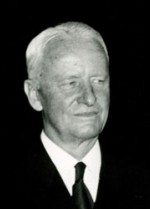Fleet Adm. Chester W. Nimitz

"When war came in the Pacific, those of us who follow the military profession had a job to do for which we had been trained all our lives," said Nimitz, receiving the Distinguished Service Medal at The American Legion's national convention in 1945. "Not so with the great majority of those who made up the conquering American forces. Overwhelmingly this war was fought and won by amateurs: citizen sailors, soldiers and Marines. The magnitude of their achievements is the more astounding when one realizes that most of the men who sailed our ships, who flew our aircraft and fired our guns, were not long away from the nation's shops and farms, offices and schools. They fought to win, and to return to the civilian pursuits suddenly interrupted by war."
As a young Texan, Nimitz was determined to attend West Point. When no appointments were available, he was accepted by the Naval Academy in Annapolis, Md. During World War I, Nimitz, a lieutenant commander, served on submarines. Two decades later, after the bombing of Pearl Harbor, Nimitz was named commander in chief of the Pacific Fleet. In late 1944, he was promoted to the new rank of fleet admiral and was aboard the USS Missouri as the U.S. signatory for the Japanese surrender.
At The American Legion convention that year, Nimitz told delegates that Japan's strengths on land and in the air were negated by its navy's weaknesses. "They surrendered because their sea power had been destroyed," he said. "Over three-quarters of their merchant shipping lay on the bottom of the ocean. They had no major naval units that could go to sea."
With victory also came additional responsibilities. "At the risk of employing a trite phrase, we must now win the peace," Nimitz said. In that vein, he served eight years as a regent at the University of California and worked diligently to build good will with Japan, even raising funds to restore a Japanese battleship. He died in California in 1966, at 80.
For more on Nimitz, click here (http://www.history.navy.mil/faqs/faq36-4.htm).
